
A mango is an edible stone fruit produced by the tropical tree Mangifera indica. It is believed to have originated in southern Asia, particularly in eastern India, Bangladesh, and the Andaman Islands. M. indica has been cultivated in South and Southeast Asia since ancient times resulting in two types of modern mango cultivars: the "Indian type" and the "Southeast Asian type". Other species in the genus Mangifera also produce edible fruits that are also called "mangoes", the majority of which are found in the Malesian ecoregion.
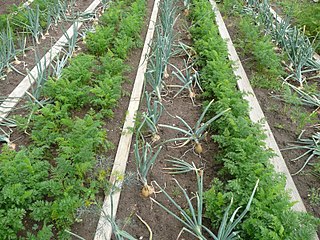
Companion planting in gardening and agriculture is the planting of different crops in proximity for any of a number of different reasons, including pest control, pollination, providing habitat for beneficial insects, maximizing use of space, and to otherwise increase crop productivity. Companion planting is a form of polyculture.

Cucurbita is a genus of herbaceous fruits in the gourd family, Cucurbitaceae, native to the Andes and Mesoamerica. Five edible species are grown and consumed for their flesh and seeds. They are variously known as squash, pumpkin, or gourd, depending on species, variety, and local parlance. Other kinds of gourd, also called bottle-gourds, are native to Africa and belong to the genus Lagenaria, which is in the same family and subfamily as Cucurbita, but in a different tribe. These other gourds are used as utensils or vessels, and their young fruits are eaten much like those of the Cucurbita species.

Squash is a non-alcoholic beverage with concentrated syrup used in beverage making. It is usually fruit-flavoured, made from fruit juice, water, and sugar or a sugar substitute. Modern squashes may also contain food colouring and additional flavouring. Some traditional squashes contain herbal extracts, most notably elderflower and ginger.

Mealybugs are insects in the family Pseudococcidae, unarmored scale insects found in moist, warm habitats. Many species are considered pests as they feed on plant juices of greenhouse plants, house plants and subtropical trees and also act as a vector for several plant diseases. Some ants live in symbiotic relationships with them, protecting them from predators and feeding off the honeydew which they excrete.

The Alphonso mango, also called the hapus mango, is a named mango cultivar that originated in India.

The silverleaf whitefly is one of several species of whitefly that are currently important agricultural pests. A review in 2011 concluded that the silverleaf whitefly is actually a species complex containing at least 40 morphologically indistinguishable species.
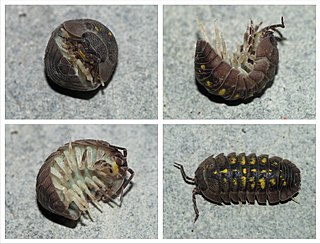
Armadillidiidae is a family of woodlice, a terrestrial crustacean group in the order Isopoda. Unlike members of some other woodlice families, members of this family can roll into a ball, an ability they share with the outwardly similar but unrelated pill millipedes and other animals. This ability gives woodlice in this family their common names of pill bugs or roly polies. Other common names include slaters,potato bugs, butchy boys and doodle bugs. Most species are native to the Mediterranean Basin, while a few species have wider European distributions. The best-known species, Armadillidium vulgare, was introduced to New England in the early 19th century and has become widespread throughout North America.
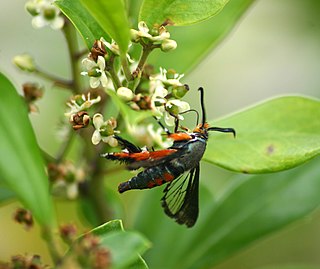
The squash vine borer is a diurnal species of sesiid moth. The moth is often mistaken for a bee or wasp because of its movements, and the bright orange hind leg scales. The females typically lay their eggs at the base of leaf stalks, and the caterpillars develop and feed inside the stalk, eventually killing the leaf. They soon migrate to the main stem, and with enough feeding damage to the stem, the entire plant may die. For this reason, it is considered a pest that attacks cultivated varieties of squash, zucchini, pumpkin, and acorn squash. The squash vine borer is native to North America, with some reports as far south as Brazil and Argentina. It lives in most temperate North American states, except the Pacific coast. Southern states have two broods a year.
Squash bug is a common name for several insects in the family Coreidae and may refer to:
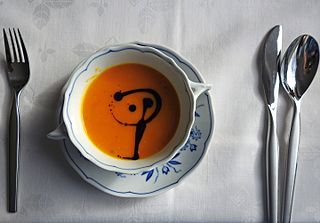
Pumpkin soup is a usually 'bound' (thick) soup made from a purée of pumpkin. It is made by combining the meat of a blended pumpkin with broth or stock. It can be served hot or cold, and is a common Thanksgiving dish in the United States. Various versions of the dish are known in many European countries, the United States and other areas of North America, in Asia and in Australia. Pumpkin soup was a staple for the prisoners of war in North Vietnamese prison camps during the Vietnam War.
Saint Lucian cuisine is a combination of French, East Indian and British dishes. Before colonization, the Caribs and the Arawaks occupied the island, surviving on its various natural fruits and vegetables like mangoes, oranges, tangerines, avocados, and breadfruits.

The 'Ataúlfo' mango is a mango cultivar from Mexico. Ataulfo mangos are golden yellow and generally weigh between 6 and 10 ounces, with a somewhat sigmoid (oblong) shape and a gold-yellow skin. The flesh is not fibrous, and the pit is thin. They were named for grower Ataulfo Morales Gordillo. Since August 27, 2003, the Ataulfo mango is one of the 18 Mexican Designations of Origin.

Tromboncino, also known as zucchetta, is a type of squash most often used as a summer squash. While nearly all summer squash are cultivars of Cucurbita pepo, tromboncino is a cultivar of Cucurbita moschata. The vining growth habit is similar to many winter squashes, but unlike most other summer squash. It is more tolerant to some common summer squash pests, including squash vine borer, squash bugs, and powdery mildew, than the more commonly grown, bushy, C. pepo summer squash cultivars. The plants are slower to start producing than some C. pepo types. The fruit color is usually pale green, fading to beige upon maturity, and it is picked around one foot long for summer squash. It is an heirloom, originally from Liguria, and remains popular throughout Italy and abroad. Tromboncino squash can be left to mature into a winter squash; such is often compared to a watery butternut squash. If left to ripen, the fruits can grow over three feet in length. Its flesh is delicious roasted or when prepared in a stew or soup.

Sternochetus mangiferae is a weevil commonly known as the mango seed weevil, mango stone weevil, or mango weevil. It is a compact weevil typical of the Cryptorhynchinae. It was first described in 1775 in the genus Curculio. The adults are 7.5-9.5 mm long and 4 mm in width.

The Indian Institute of Horticultural Research (IIHR) is an autonomous organization acting as a nodal agency for basic, strategic, anticipatory and applied research on various aspects of horticulture such as fruits, vegetable, ornamental, medicinal and aromatic plants and mushrooms in India. The institute has its headquarters in Bengaluru, Karnataka, India and is a subsidiary of Indian Council of Agricultural Research (ICAR), New Delhi, under the Ministry of Agriculture, India. It recently has been ranked 1st for the combined years 2019-20 and 2020-21 by the ICAR.
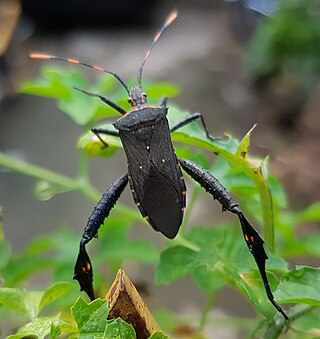
Leptoglossus gonagra, known as the passionvine bug, citron bug or squash bug in different parts of its range, is a species of leaf-footed bug in the family Coreidae. It is found in Africa, the Caribbean, Central America, North America, South America, Southern Asia, the Pacific Ocean and Oceania.
Deporaus marginatus, commonly known as the mango leaf-cutting weevil, is a species of leaf weevil in the beetle family Attelabidae. It is a light tan colour with black elytra, and is found in tropical Asia where it is a pest of mango.

Magadi Puttarudriah was an Indian entomologist who worked in the Government of Mysore and after 1957 in the Government of Karnataka. He was the first professor of entomology at the University of Agricultural Sciences, Bangalore created in 1964.
The Panchadara Kalasa is a variety of mango native to Andhra Pradesh, India, specifically in the East Godavari district. It is also grown in Telangana, the coastal areas of Andhra Pradesh and Rayalaseema. The name Panchadara Kalasa translates to "sugar pot" in English, referencing its taste and pot-like shape.
















